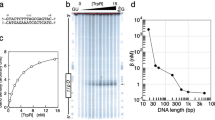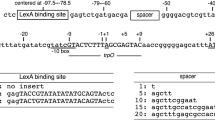Abstract
The interaction of the trp repressor with several trp operator DNA fragments has been examined by DNA gel retardation assays and by circular dichroism, in the absence and presence of the corepressor l-tryptophan. The holorepressor binds stoichiometrically to both the trpO and aroH operators, forming 1:1 complexes. In the presence of excess protein, additional complexes are formed with these operator fragments. The relative electrophoretic mobilities of the 1:1 complexes differ significantly for trp and aroH operators, indicating that they differ substantially in gross structure. A mutant trp operator, trpO c, has low affinity for the holorepressor, and forms only complexes with stoichiometries of 2:1 (repressor: DNA) or higher, which have a very low electrophoretic mobility. Specific binding is also accompanied by a large increase in the intensity of the near ultraviolet circular dichroism, with only a small blue shift, which is consistent with significant changes in the conformation of the DNA. Large changes in the chemical shifts of three resonances in the 31P NMR spectrum of both the trp operator and the aroH operator occur on adding repressor only in the presence of L-tryptophan, consistent with localised changes in the backbone conformation of the DNA.
Similar content being viewed by others
Abbreviations
- CD:
-
circular dichroism
- trpO, trpR :
-
aroH trp operator fragments
- trpO c :
-
trpMH mutant trp operator fragments
References
Bass S, Sorrells V, Youderian D (1988) Mutant Trp Repressors with New DNA-Binding Specificities. Science 242:240–245
Bass S, Sugiono P, Arvidson DN, Gunsalus RP, Youderian P (1987) DNA specificity determinants of Escherichia coli tryptophan repressor binding. Genes & Devel 1:565–572
Borden KLB, Beckmann P, Lane AN (1991) Determination of the orientations of tryptophan analogues bound to the trp repressor and the relationship to activation. Eur J Biochem 202:459–470
Carey J (1988) Gel retardation at low pH resolved trp repressor DNA complexes for quantitative study. Proc Natl Acad Sci 85:975–979
Carey J, Lewis DEA, Lavoie TA, Yang J (1991) How does trp repressor bind to its operator. J Biol Chem 266:24509–24513
Chandler LR, Lane AN (1988) Interaction of the trp repressor from Escherichia coli with a constitutive trp operator. Biochem J 250: 925–928
Fernando T, Royer CA (1992) Unfolding of the trp repressor studied using fluorescence spectroscopic techniques. Biochemistry 31:6683–6691
Garner MM, Revzin A (1990) Gel electrophoresis of nucleic acids. A practical approach. Rickwood D, Hames BD (eds) IRL press. Oxford chapt 6
Gerothanassis IP, Birdsall B, Feeney J (1991) Hydrogen bonding effects on 31P NMR shielding in the pyrophosphate group of NADPH bound to L. casei dihydrofolate reductase. FEBS Lett 291:21–23
Gorenstein DG, Jones RJ, Schroeder SA, Metz JT, Fu JM, Roongta VA, Powers R, Karslake C, Nikonowicz E Santini R (1991) In: NMR and Biomolecular Structure. Bertini I, Molinari H, Niccolai N (eds) VCH Weinheim chapt 6
Gunsalus RP, Yanofsky C (1980) Nucleotide sequence and expression of Escherichia coli trpR, the structural gene for the trp aporepressor. Proc Natl Acad Sci 77:7117–7121
Haran TE, Joachimiak A, Sigler PB (1992) The DNA target of the trp repressor. EMBO J 11:3021–3030
Hunter WN, D'Estaintot BL, Kennard O (1989) Structural Variation in d(CGCTAGAG). Implications for Protein-DNA Interactions. Biochemistry 28:2444–2451
Ivanov VI, Minchenkova LE, Schyolkina AK, Poletayev AI (1973) Different conformations of double-stranded nucleic acids in solution as revealed by circular dichroism. Biopol 12:89–110
Joachimiak A, Kelley RL, Gunsalus RP, Yanofsky C, Sigler PB (1983) Purification and characterisation of trp aporepressor. Proc Nail Acad Sci 80:668–672
Klig LS, Crawford IP, Yanofsky C (1987) Analysis of trp repressor operator interaction by filter binding. Nucl Acids Res 15:5339–5351
Klig L, Carey J, Yanofsky C (1988) trp Repressor Interactions with the trp, aroH and trpR Operators. J Mol Biol 202:769–777
Kumamoto AA, Miller WG, Gunsalus RP (1987) Escherichia coli tryptophan repressor binds multiple sites within the aroH and trp operators. Genes & Devel1:556–564
Lane AN, Lefèvre J-F, Jardetzky O (1987) The Interaction of the trp repressor from Escherichia coli with the trp operator. Biochim Biophys Acta 900:58–70
Lane AN (1991 a) The solution conformations of a mutant trp operator determined by NMR spectroscopy. Biochem J 273:383–391
Lane AN (1991 b) Solution conformation and dynamics of the octadeoxynucleotide d(CACTAGTG)2: a multinuclear NMR relaxation study. Carbohyd Res 221:123–144
Marmorstein RQ, Sigler PB (1989) Stereochernical Effects of L-Tryptophan and Its Analogues on trp Repressor's Affinity for Operator-DNA. J Biol Chem 264:9149–9154
Marmorstein RQ, Sprinzl M, Sigler PB (1991) An Alkaline Phosphatase Protection Assay To Investigate trp Repressor/Operator Interactions Biochemistry 30:1141–1148
Oppenheim DS, Bennett G, Yanofsky C (1980) Escherichia coli RNA Polymerase and trp Repressor Interaction with the Promoter-Operator Region of the Tryptophan Operon of Salmonella Typhimurium. J Mol Biol 144:133–142
Otwinowski Z, Schevitz RW, Zhang R-G, Lawson CL, Joachimiak A, Marmorstein RQ, Luisi BF, Sigler PB (1988) Crystal structure of trp repressor/operator complex at atomic resolution. Nature 335:321–329
Phillips SEV, Manfield I, Parsons I, Rafferty JB, Somers WS, Margarita D, Cohen GN, Santi-Girons I, Stockely PG (1989) Cooperative Tandem Binding in the E. coli Methionine Repressor. Nature 341:711–714
Phillips SEV (1991) Specific β-sheet interactions. Curr Opinions Str Biol 1:89–98
Sprecher CA, Baase WA, Johnson WC Jr (1979) Conformation and circular dichroism of DNA. Biopol 18:1009–1019
Staacke D, Walter B, Kisters-Woike B, Wilcken-Bergmann B, Müller-Hill B (1990) How Trp repressor binds to its operator. EMBO J 9:1963–1967
Author information
Authors and Affiliations
Rights and permissions
About this article
Cite this article
Beckmann, P., Martin, S.R. & Lane, A.N. Interaction of the trp repressor with trp operator DNA fragments. Eur Biophys J 21, 417–424 (1993). https://doi.org/10.1007/BF00185869
Received:
Accepted:
Issue Date:
DOI: https://doi.org/10.1007/BF00185869




